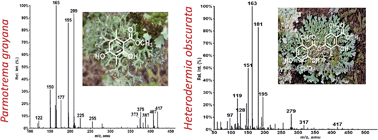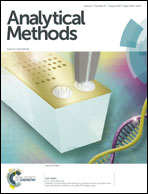Rapid identification of lichen compounds based on the structure–fragmentation relationship using ESI-MS/MS analysis†
Abstract
Lichens are symbiotic composites of algae and fungi which produce characteristic secondary metabolites of interest. This study, based on negative mode electrospray quadrupole time-of-flight mass spectrometry (ESI-Qq-TOF-MS/MS), reveals the structure–fragmentation relationship of ten metabolites belonging to various chemical classes such as monocyclic phenols, depsides, depsidones and dibenzofurans. Low energy collision induced dissociation tandem mass spectrometric analysis of these deprotonated molecules yielded key fragments due to the loss of neutral components like CO, CO2, methanol, ethanol, and ethene. Interestingly, odd electron fragments were also observed in sekikaic acid, lobaric acid, and usnic acid as characteristic fragments. The fragmentation pattern of standard compounds, high resolution analysis and database were used for the rapid identification of compounds in lichen species, Parmotrema grayana and Heterodermia obscurata. Furthermore MS/MS spectra revealed different fragmentation pathways for different classes of secondary metabolites. In total fifteen compounds were identified from the methanolic and dichloromethane extracts of Parmotrema grayana and Heterodermia obscurata.


 Please wait while we load your content...
Please wait while we load your content...